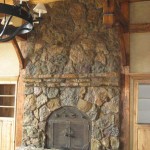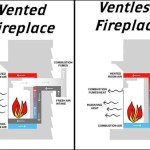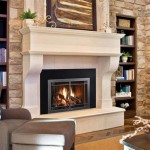How To Use Fire Glass In A Fireplace: A Comprehensive Guide
Fire glass, also known as fire pit glass or fire beads, has become a popular alternative to traditional gas logs in fireplaces and fire pits. Its aesthetic appeal, durability, and heat-retention capabilities make it an attractive option for enhancing the ambiance of both indoor and outdoor spaces. Understanding how to properly use fire glass in a fireplace is crucial for safety and optimal performance. This article provides a detailed guide on the process, covering preparation, installation, maintenance, and safety considerations.
The shift towards fire glass is driven by its modern look and versatility. Unlike logs, fire glass comes in a wide array of colors, shapes, and sizes, allowing for customization to match various décor styles. The reflective properties of the glass also create a visually stunning display, enhancing the overall atmosphere of any fire feature. Furthermore, fire glass does not produce ash, smoke, or soot, contributing to a cleaner burning environment.
Preparing the Fireplace for Fire Glass
Before introducing fire glass to a fireplace, thorough preparation is necessary. This preparation involves assessing the fireplace’s compatibility, cleaning the existing system, and ensuring proper ventilation. Failing to undertake these preliminary steps can lead to performance issues or safety hazards.
The first step is to determine if the fireplace is suitable for fire glass. Fire glass is designed for use with gas fireplaces, whether natural gas or propane. Wood-burning fireplaces are not compatible unless they are converted to gas. If the fireplace is already gas-powered, inspect the burner system to ensure it is in good working order. Look for any signs of corrosion, damage, or leaks. If any problems are identified, consult a qualified professional to repair or replace the components.
Next, the fireplace and its immediate surroundings must be thoroughly cleaned. Remove any remaining ash, debris, or old gas logs. Use a brush and vacuum to clean the firebox, paying close attention to the burner system and any crevices. Wipe down the interior surfaces with a damp cloth to remove any residual dust or soot. A clean firebox ensures optimal airflow and reduces the risk of contaminants affecting the fire glass.
Ventilation is a critical aspect of fireplace safety. Ensure that the fireplace has proper ventilation to allow for the safe dissipation of combustion gases. Inspect the chimney or vent system for any obstructions or blockages. If there are any concerns about ventilation, consult a qualified professional to assess and rectify the issue. Insufficient ventilation can lead to carbon monoxide buildup, posing a serious health risk.
Finally, consider the type of burner system installed in the fireplace. Different burner designs can influence the type and quantity of fire glass needed. Linear burners, for example, require a different arrangement of fire glass compared to standard ring burners. Understanding the burner system's specifications will ensure that the fire glass is properly distributed for even flame distribution and efficient heat output.
Installing Fire Glass
The installation process involves selecting appropriate fire glass, calculating the required quantity, and carefully arranging the glass within the firebox. Adhering to these steps will guarantee not only optimal aesthetic appeal but also a safe and efficient operation.
Choosing the right type of fire glass is essential. Fire glass is available in various sizes, colors, and shapes. Smaller pieces, typically around ¼ inch to ½ inch, are suitable for smaller fireplaces, while larger pieces, up to 1 inch, are often preferred for larger fire features. The color selection is a matter of personal preference, allowing homeowners to create a unique look that complements their décor. Consider the reflective properties of the glass, as some types are more reflective than others, enhancing the visual impact of the flames.
Calculating the amount of fire glass needed is crucial to avoid underfilling or overfilling the firebox. Too little fire glass may result in uneven flame distribution, while too much can obstruct the burner system. Most fire glass suppliers offer online calculators to estimate the required quantity based on the dimensions of the firebox. As a general guideline, measure the length, width, and depth of the area where the fire glass will be placed. Input these measurements into the calculator to determine the appropriate volume of fire glass in pounds or kilograms.
Once the fire glass and quantity are determined, the installation process can begin. First, cover the burner system with a base layer of sand or lava rock. This step is crucial for protecting the burner from direct contact with the fire glass, extending its lifespan and ensuring even gas distribution. The base layer also helps to reduce the amount of fire glass needed, as it fills the lower portion of the firebox.
Carefully pour the fire glass over the base layer, ensuring that it is evenly distributed throughout the firebox. Avoid covering the pilot light or any essential components of the burner system. In order to ensure that the flames are not obstructed from the fire glass, it is recommended to leave a few inches space around the pilot light to prevent any potential difficulties when igniting the fireplace.
Arranging the fire glass is an opportunity to create a visually appealing display. Consider layering different colors or sizes of fire glass to add depth and texture. You can also create patterns or designs by strategically placing the glass. However, ensure that the arrangement does not obstruct the burner ports or impede the flow of gas. A well-arranged fire glass display enhances the aesthetic appeal of the fireplace and contributes to an enjoyable viewing experience.
Maintaining and Ensuring Safety with Fire Glass
Regular maintenance and adherence to safety guidelines are essential for ensuring the longevity of the fire glass and the safe operation of the fireplace. This involves cleaning the fire glass, inspecting the burner system, and adhering to safety precautions.
Cleaning the fire glass is important for maintaining its reflective properties and preventing the buildup of soot or contaminants. Over time, fire glass can accumulate dust, dirt, and soot, diminishing its luster and potentially affecting the flame quality. To clean fire glass, remove it from the firebox and rinse it with a solution of mild soap and water. Use a soft brush to remove any stubborn residue. Rinse the glass thoroughly with clean water and allow it to dry completely before returning it to the fireplace. Regular cleaning, typically every few months, will keep the fire glass looking its best.
Inspecting the burner system should be a routine part of fireplace maintenance. Check for any signs of corrosion, damage, or leaks. Ensure that the burner ports are clear of debris. If any problems are identified, consult a qualified professional to repair or replace the components. A well-maintained burner system ensures safe and efficient operation of the fireplace.
Safety precautions are paramount when using a gas fireplace with fire glass. Never use the fireplace if you suspect a gas leak. If you detect the odor of gas, immediately turn off the gas supply and evacuate the area. Contact a qualified professional to inspect and repair the system. Ensure that the fireplace is installed and maintained in accordance with local codes and regulations. Keep flammable materials away from the fireplace and never leave the fireplace unattended while it is in operation.
Furthermore, it is crucial to understand that not all glass is suitable for use as fire glass. Ordinary glass can shatter or explode when exposed to high temperatures, posing a serious safety hazard. Genuine fire glass is specifically manufactured to withstand the extreme heat of a fireplace without cracking, discoloring, or emitting harmful fumes. Always purchase fire glass from a reputable supplier and ensure that it is certified for use in gas fireplaces.
Proper storage of fire glass when not in use can also contribute to its longevity. Store the glass in a dry, airtight container to prevent moisture and contaminants from affecting its quality. Avoid storing the glass in direct sunlight, as prolonged exposure to UV rays can cause discoloration. By following these storage guidelines, you can keep your fire glass in excellent condition for years to come.
In summary, using fire glass in a fireplace requires careful planning, preparation, and maintenance. By following the steps outlined in this guide, homeowners can enjoy the aesthetic appeal and warmth of fire glass while ensuring the safety and longevity of their fireplace system. From selecting the appropriate fire glass to maintaining and storing it correctly, each step contributes to an optimal and secure fireplace experience.

Fire Pit Glass Everything You Need To Know

Fireplace Installation Instructions Diamond Fire Glass

Austin Fire Glass Fireplace Installation Backyard Oasis

How To Install Fire Glass In A Fireplace By Diamond

Fireplaces S Of Gas Fire Glass Designed With Affordable Glassfire

How To Add Fire Glass Your Gas Fireplace

How To Install Fire Glass In A Fireplace By Diamond

How To Clean Fire Glass

24 X 6 Stainless Steel H Style Burner Natural Gas

Element Fire Glass 1 2 Cobalt Blue Reflective 10lbs Com
Related Posts








